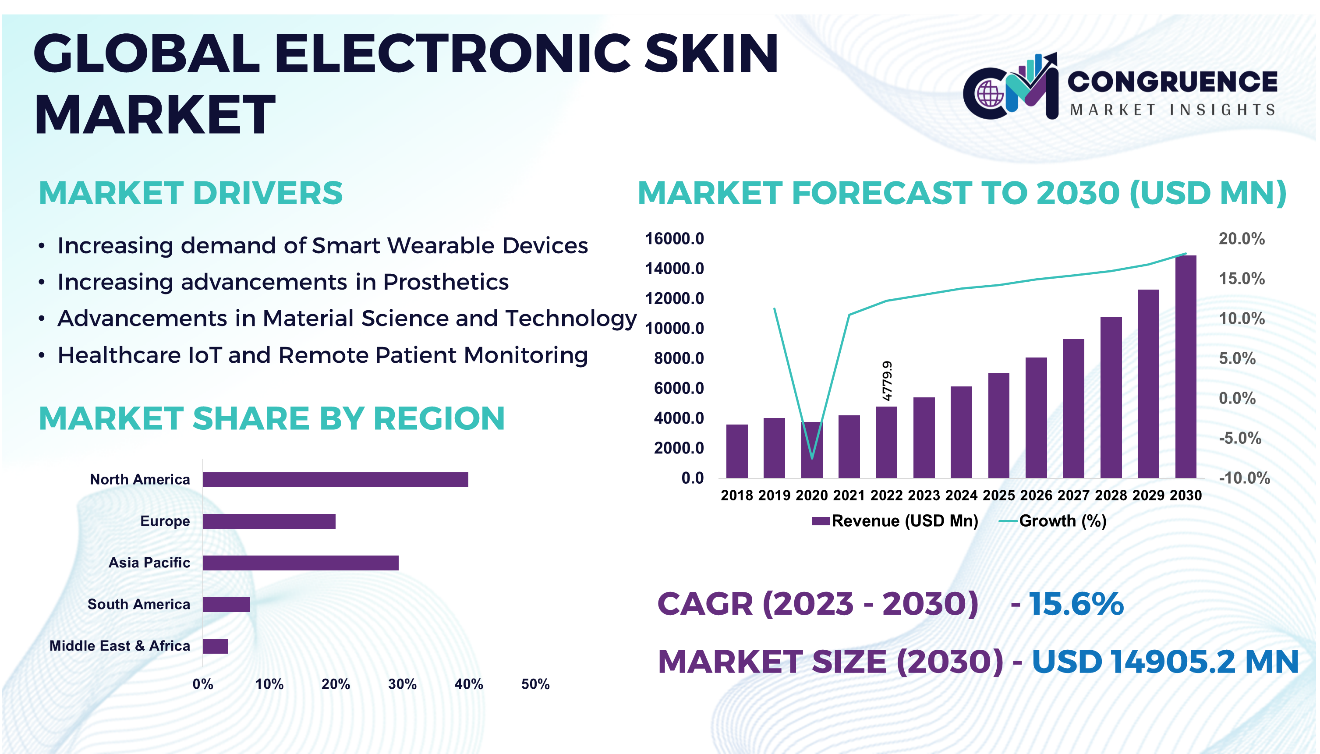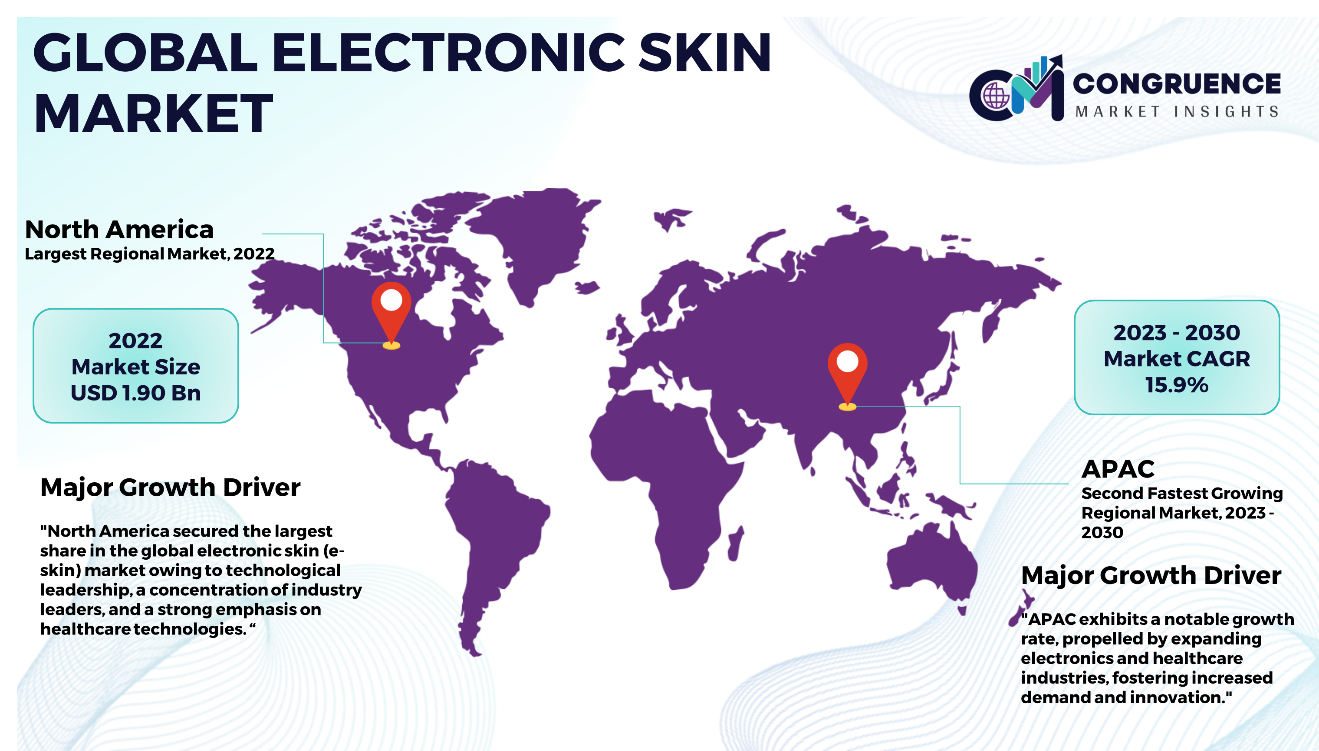Reports
The Global Electronic Skin Market was valued at USD 4,779.9 Million in 2022 and is anticipated to reach a value of USD 14,905.2 Million by 2030 expanding at a CAGR of 15.6% between 2023 and 2030.
A electronic skin is a quilted blanket that has a natural or artificial filling and is covered by a removable cover. The insert consists of a quilted shell with synthetic or natural fluff inside. In contrast to comforters, Electronic Skin can be changed in style and feel at any time by replacing the cover. A electronic skin set consists of a electronic skin cover, a matching pair of pillow shams, and a electronic skin insert. However, an electronic skin cover set normally consists of the cover and coordinating linens, with the electronic skin insert being offered separately. A typical electronic skin filler generally includes wool, feathers, cotton, microfiber, polyester, and silk among others. The market is influenced by factors such as seasonal demand, trending designs in bedding, as well as the rising popularity of eco-friendly and hypoallergenic options. The electronic skin market serves both residential customers and commercial establishments such as hotels and hospitality businesses.

Electronic Skin Market Major Driving Forces
Increasing demand of Smart Wearable Devices: The growing embrace of wearable devices, particularly for health and fitness monitoring, fuels the demand for electronic skin technologies. E-skin plays a pivotal role in crafting health monitoring solutions that are both comfortable and non-intrusive.
Increasing advancements in Prosthetics: The expanding demographic of individuals with limb differences and an aging population is propelling the need for advanced prosthetics with heightened sensory capabilities. Electronic skin is crucial in delivering lifelike and responsive feedback within prosthetic limbs.
Advancements in Material Science and Technology: Continual progress in flexible and stretchable materials contributes to the creation of more resilient and adaptable electronic skin. Innovations in material science enable e-skin to closely mimic the properties of natural skin.
Healthcare IoT and Remote Patient Monitoring: The proliferation of the Internet of Things (IoT) in healthcare, coupled with an increased focus on remote patient monitoring, accelerates the adoption of e-skin for continuous health tracking. E-skin facilitates real-time data collection and transmission for various healthcare applications.
Electronic Skin Market Key Opportunities
Increasing Investments for Innovations in Flexible Electronics: The flexibility provided by materials in electronic skins presents an advantage, allowing for applications in a wide range of areas such as robotics, wearables, and healthcare.
Rise of Virtual and Augmented Reality: The ability of electronic skin (e-skin) to deliver authentic tactile feedback in virtual environments elevates the immersive experience, playing a role in advancing more sophisticated applications in virtual reality (VR) and augmented reality (AR).
Wearable Electronics and Smart Clothing: Incorporating e-skin into smartwatches, fitness trackers, and smart clothing creates opportunities to enhance user experience and expand functionality within the domain of wearable electronics.
Electronic Skin Market Key Trends
· The application of e-skin technologies is enhancing human-robot interaction, promoting secure and intuitive collaboration across diverse industries.
· E-skin is progressively being incorporated into wearable devices like smartwatches and fitness trackers to facilitate continuous health monitoring, thereby contributing to the broader trend of heightened personal health awareness.
· Incorporating e-skin to offer tactile feedback in virtual reality (VR) experiences involves simulating authentic touch sensations, thereby contributing to the advancement of increasingly sophisticated VR environments.
· The growing incorporation of electronic skin into healthcare applications within the Internet of Things (IoT).
· The incorporation of electronic skin (e-skin) into educational and training simulations heightens the authenticity of scenarios in healthcare training, industrial training, and defense applications, thereby enhancing the overall quality of learning experiences.
Region-wise Market Insights
North America accounted for the largest market share at 39.9% in 2022 whereas, Asia Pacific is expected to register the second fastest growth, expanding at a CAGR of 15.9% between 2023 and 2030.

The global electronic skin (e-skin) market presents a dynamic and diverse landscape, characterized by distinctive trends and opportunities that vary across different geographical regions. Notably, North America has emerged as a pivotal player in the e-skin market, owing to its robust technological innovation ecosystem and the influential presence of key industry players. The region's strong emphasis on healthcare technologies and the widespread adoption of wearable devices for health monitoring have significantly propelled the growth of the e-skin market.
In Europe, strategic investments in research and development, particularly in countries such as Germany and the United Kingdom, have played a crucial role in fostering advancements in e-skin technologies. The continent's commitment to innovation has contributed to the evolution of the e-skin market. In the Asia-Pacific region, substantial growth has been observed, driven by the expansive electronics and healthcare industries in countries like China, Japan, and South Korea. The region's heightened focus on robotics, coupled with the surge in consumer electronics, has generated substantial demand for e-skin solutions.
Concurrently, in emerging markets such as Latin America and the Middle East, there has been a notable increase in awareness regarding the benefits of electronic skin. This heightened awareness has translated into opportunities, particularly in healthcare and industrial applications, as these regions actively seek to leverage e-skin technologies for various beneficial purposes. The global e-skin market's intricate dynamics underscore the importance of considering regional variations and market-specific factors when assessing the industry's trajectory.
Segment-wise Market Analysis
· Skin patches secured a major share in the global electronic skin (e-skin) market as a preferred product type. Their popularity can be attributed to their non-invasive nature, ease of application, and versatility in health monitoring. Skin patches offer seamless integration into daily routines, contributing to their widespread adoption for continuous health tracking, leading to their significant presence and influence in the evolving e-skin market.
· Inorganic materials have claimed a substantial share in the global electronic skin (e-skin) market. Their prevalence is due to their robust properties, providing durability and enhanced performance. In applications ranging from robotics to healthcare, inorganic materials have become integral, driving their significant representation in the market and contributing to the advancement and diversification of e-skin technologies across various industries.
Market Competition Landscape
The global electronic skin (e-skin) market boasts a vibrant competition landscape, featuring key players at the forefront of technological innovation. Medidata, a subsidiary of Dassault Systèmes, brings substantial expertise in the health technology domain, contributing to the evolution of wearable electronic solutions. VivaLNK, Inc., recognized for its continuous health monitoring solutions, plays a pivotal role in shaping the market with its cutting-edge applications. Xsensio, a notable player specializing in wearable biochemical sensors, adds diversity to the market by offering advanced sensing capabilities. Xenoma Inc. is a prominent participant known for its expertise in smart apparel, contributing to the development of intelligent and responsive e-skin technologies. Epicore Biosystems, Inc., with its focus on innovative biosensor solutions, plays a crucial role in advancing the capabilities of electronic skin for various applications.
These companies exemplify the diversity and dynamism within the e-skin market, each bringing unique strengths and perspectives. The competitive landscape is characterized by a fusion of established players and emerging innovators, reflecting a commitment to pushing the boundaries of e-skin applications. Collaborations, research initiatives, and technological advancements remain key elements in driving competition and fostering growth within this rapidly evolving market.
Key players in the global electronic skin market implement various organic and inorganic strategies to strengthen and improve their market positioning. Prominent players in the market include:
· Medidata (Dassault Systèmes)
· VivaLNK, Inc.
· Xsensio
· Xenoma Inc.
· Epicore Biosystems, Inc.
· Holst Centre
· Edinburgh Innovations
· StretchSense (Sensor Holdings Limited company)
· Sensoria
· NeuroSky
· AiQ Smart Clothing
· GENTAG, Inc.
· Others
|
Report Attribute/Metric |
Details |
|
Market Revenue in 2022 |
USD 4,779.9 Million |
|
Market Revenue in 2030 |
USD 14,905.2 Million |
|
CAGR (2023 – 2030) |
15.6% |
|
Base Year |
2022 |
|
Forecast Period |
2023 – 2030 |
|
Historical Data |
2018 to 2022 |
|
Forecast Unit |
Value (US$ Mn) |
|
Key Report Deliverable |
Revenue Forecast, Growth Trends, Market Dynamics, Segmental Overview, Regional and Country-wise Analysis, Competition Landscape |
|
Segments Covered |
· By Product Type (Skin Patch, and Skin Suite) · By Material (Material, and Inorganic) · By Application (Health Monitoring, Prosthetics, Fitness Tracking, and Others) · By End-Use Industry (Healthcare and Medical Science, Electronics, Robotics, and Others) |
|
Geographies Covered |
North America: U.S., Canada and Mexico Europe: Germany, France, U.K., Italy, Spain, and Rest of Europe Asia Pacific: China, India, Japan, South Korea, Southeast Asia, and Rest of Asia Pacific South America: Brazil, Argentina, and Rest of Latin America Middle East & Africa: GCC Countries, South Africa, and Rest of Middle East & Africa |
|
Key Players Analyzed |
Medidata (Dassault Systèmes), VivaLNK, Inc., Xsensio, Xenoma Inc., Epicore Biosystems, Inc., Holst Centre, Edinburgh Innovations, StretchSense (Sensor Holdings Limited company), Sensoria, NeuroSky, AiQ Smart Clothing, GENTAG, Inc., and Others |
|
Customization & Pricing |
Available on Request (10% Customization is Free) |
